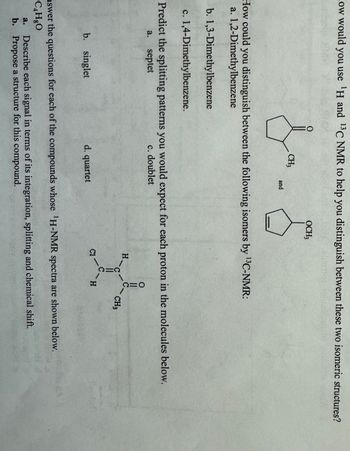
Organic Chemistry
9th Edition
ISBN: 9781305080485
Author: John E. McMurry
Publisher: Cengage Learning
expand_more
expand_more
format_list_bulleted
Question

Transcribed Image Text:How would you use 'H and 13 C NMR to help you distinguish between these two isomeric structures?
OCH3
CH₁
and
How could you distinguish between the following isomers by 13C-NMR:
a. 1,2-Dimethylbenzene
b. 1,3-Dimethylbenzene
c. 1,4-Dimethylbenzene.
Predict the splitting patterns you would expect for each proton in the molecules below.
a.
septet
c. doublet
H
ΟΞΥ
CH3
b. singlet
d. quartet
2
H
nswer the questions for each of the compounds whose 'H-NMR spectra are shown below.
C4H8O
a.
Describe each signal in terms of its integration, splitting and chemical shift.
b. Propose a structure for this compound.
Expert Solution
This question has been solved!
Explore an expertly crafted, step-by-step solution for a thorough understanding of key concepts.
Step by stepSolved in 2 steps with 2 images

Knowledge Booster
Similar questions
- THIS CAN NOT BE HAND DRAWN! MUST BE DIGITALLY ILLUSTRATED OR USE A PC PROGRAM TO DO SO!arrow_forwardShow the calculation step by step.arrow_forward13. The molecular formula of the compound responsible for the below spectrum is C9H20. What is its structural formula? 3 N PPM 2H 3H IHD= 2(9)+2-20 2arrow_forward
- I would an explanation on how to anwser this questionarrow_forwardCan someone please check my work, for B one my my friends said the structure was completely wrong please helparrow_forward2. Consider the two ¹H NMR spectra sketched below that correspond to the molecule shown. Assign the peaks in each spectrum to the different sets of equivalent protons in the molecule. Why do the spectra for this molecule look different when measured at different temperatures? IN 84°C M 38°C 3 N 1 ppmarrow_forward
- Given below are the ¹H NMR spectra of two isomeric compounds with the molecular formula C4H₂O₂. Spectrum X 3 C₂HgO₂ 11 Spectrum Y 10 9 8 0 11 10 ppm Using the following choices, determine which compound corresponds to which spectrum. LOCH 3 A. B. C. b D. C₂H₂O₂ مله 6 OH pom 3 6arrow_forwardWhat structure is consistent with these spectra? 8. 6 PPM 12 10 8 4 2 200 160 140 120 100 PPM 180 80 60 40 20 OH HO, HO.arrow_forward8. Sketch the off-resonance-decoupled 1³C spectra of the following compound. H H C C-H H The splitting pattern of off-resonance decoupled spectrum indicates the number of protons attached to the carbon. 13C nuclei are split only by the protons attached directly to them. The N + 1 rule applies: a carbon with N number of protons gives a signal with N + 1 peaks (e.g. carbon atom with one proton appears as a doublet; carbon with two attached protons gives a triplet etc.) • Carbon atoms with more hydrogens absorb more strongly.arrow_forward
- Which structure is consistent with an [M] peak and an [M+2]" peak in the ratlo of 3:17 Click on a letter A through C to answer, А. Br CI В. NH2 С.arrow_forward12. The 'H-NMR spectra of three isomers with the formula C4H9BR are shown below. Which isomer produces each spectrum? 1.1 10 09 PM 6 8 (ppm) frequency 2 6. 4 8 (ppm) frequency na 8 7 4 ô (ppm) frequencyarrow_forward7. Which of the molecules below correspond to which of the 'H NMR spectra? Explain your choice. Note that in both spectra below, the peaks are singlets of 3H or 9H. FUX 18 # 3H A Denting 3 10 9 8 7 6 5 4 OCH 3 4 +2 9H 1 1 B J 3H Cada 3 2 7 6 5 4 10 9 8 7 9H 1arrow_forward
arrow_back_ios
SEE MORE QUESTIONS
arrow_forward_ios
Recommended textbooks for you
